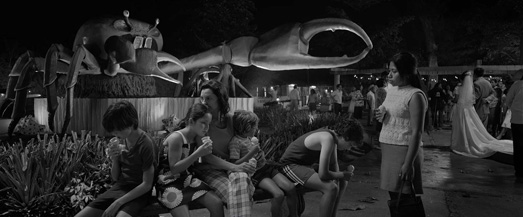|
|
Movie Review: RomaBy Matthew HuntleyJanuary 1, 2019
Cleo finds her rather mundane life suddenly upended when she discovers she’s pregnant, but when she tells Fermín, he literally runs for the hills, leaving her to the care of Sofía and Sofía’s live-in mother, Teresa (Verónica García). This development allows us to see that Sofía and Teresa view Cleo as more than just a maid, which also catches us off guard, especially because we assume Sofia is too wrapped up in the stresses of her own failing marriage to care about Cleo. But one of the points Cuarón wants to make with “Roma” is that when human beings need each other, especially in times of desperation, it’s our basic goodness and compassion that prevails. In addition to her own domestic and personal unrest, Cleo’s pregnancy coincides with the social upheaval of the time. Amid the Mexican Dirty War, Cleo and Teresa witness a tragedy following the infamous Corpus Christi Massacre of 1971, when student protestors were killed by soldiers from the Mexican army. This leads to a dangerous confrontation with Fermín, who previously threatened Cleo if she ever accused him of being the father of their unborn child. What transpires is no wonder given all that Cleo has to bear, and while the film does pack an emotional wallop in regard to her own personal struggles, it’s important to recognize this is not just Cleo’s story. Cuarón, by presenting all the film’s events slowly, quietly and impartially, and by lending weight and dimension to all the characters and their situations, wants us to grasp this could really be anyone’s story, including our own. He wants us to consider the idea that humans create chaos for themselves and it’s us who happen to this world, not the other way around. He’s bold and patient in the way he simply allows the camera to sit and observe as the personal and social pressures mount and release. The result is a film that reiterates humans are part of a collective unit and we’re all in this crazy life together, so we should do our best to help each other along as best we can. Given all the “chaos” of the plot and way the characters’ lives spiral out of control and meet near-fatal ends, it would stand to reason “Roma” would be colorful instead of black and white; the camera would move fast instead of slow; and Cuarón and co-editor Adam Gough would make a lot more cuts. And while such a strategy often works (“City of God” comes to mind), “Roma” wants show that the external happenings in our lives are fleeting. The camera and imagery, by remaining calm and balanced throughout, represent our inherent goodness, which doesn’t change. It’s something we all possess and should strive to come back to. The more apparent the film’s underlying meaning becomes, the more it dawns on us the details of the plot, including the time, location and people, are incidental. This goes along with the idea that the details in our own lives, to which we ascribe so much meaning, whether they’re good or bad, tedious or exciting, tragic or blessed, are basically impermanent, while it’s our essential needs to love and be loved that does not. I’ll not give away what happens in the “Roma” that made me come to this conclusion, and I don’t claim to be absolutely right about its meaning, but I do know the way I perceived the film speaks to its power. What’s also beautiful about it is that it proves just as effective as a “traditional” human drama, with its complex characters whom we care for and empathize with, whom we view as real, vulnerable beings, each flawed and lovable in his or her own way. We appreciate everything they endure, both personally and in the context of the important social and historical events. However anyone sees it, Cuarón’s “Roma” is arguably special. To me, it’s a representation of humanity and the kind of film you could watch over and over again and still pick up on new things each time. In this regard, it mirrors how we’re constantly reexamining our own lives and how wonderful it is that we always manage to discover something new about who we are. But however much we find out more about ourselves, it’s important to remember our basic goodness is always there and it’s a quality shared by everyone.
|

|
|
|

|
Thursday, October 31, 2024
© 2024 Box Office Prophets, a division of One Of Us, Inc.


